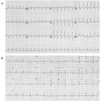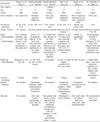Abstract
A 52-year-old female was admitted to the hospital with abdominal pain. Her electrocardiogram revealed ST depressions in leads II, III, aVF and V2-5. The echocardiography showed transient cardiomyopathy with akinesia of the basal and mid portions of the left ventricle and hyperkinesia of the apex. There was no evidence of any vascular lesion on the emergency coronary angiography. She was diagnosed with pheochromocytoma by abdominal computed tomography and the post-operative pathologic examinations. These findings led us to a diagnosis of inverted Takotsubo cardiomyopathy related with pheochromocytoma. The recognition of such a rare cardiac manifestation should be considered in the diagnosis of pheochromocytoma, and especially in the circumstances of acute heart failure.
Figures and Tables
Fig. 1
The electrocardiogram revealed significant ST depression in leads II, III, aVF, and V2-V5 on admission day (A). The electrocardiogram revealed normal sinus rhythm with non-specific ST segment changes on 5th day (B).

Fig. 2
The transthoracic echocardiography showed akinesia of the basal and mid portion of left ventricle and hyperkinesia of the apex on admission day (A and B). Left ventricular abnormal wall movement was improved on the 6th day (C and D).

References
1. Shimizu M, Takahashi H, Fukatsu Y, Tatsumi K, Shima T, Miwa Y, Okada T, Fujita M. Reversible left ventricular dysfunction manifesting as hyperkinesis of the basal and the apical areas with akinesis of the mid portion: a case report. J Cardiol. 2003. 41:285–290.
2. Yasu T, Tone K, Kubo N, Saito M. Transient mid-ventricular ballooning cardiomyopathy: a new entity of Takotsubo cardiomyopathy. Int J Cardiol. 2006. 110:100–101.
3. Van de Walle SO, Gevaert SA, Gheeraert PJ, De Pauw M, Gillebert TC. Transient stress-induced cardiomyopathy with an "inverted takotsubo" contractile pattern. Mayo Clin Proc. 2006. 81:1499–1502.
4. Bybee KA, Kara T, Prasad A, Lerman A, Barsness GW, Wright RS, Rihal CS. Systematic review: transient left ventricular apical ballooning: a syndrome that mimics ST-segment elevation myocardial infarction. Ann Intern Med. 2004. 141:858–865.
5. Ako J, Sudhir K, Farouque HM, Honda Y, Fitzgerald PJ. Transient left ventricular dysfunction under severe stress: brain-heart relationship revisited. Am J Med. 2006. 119:10–17.
6. Lee YP, Poh KK, Lee CH, Tan HC, Razak A, Chia BL, Low AF. Diverse clinical spectrum of stress-induced cardiomyopathy. Int J Cardiol. 2009. 133:272–275. 2008.
7. Takeno Y, Eno S, Hondo T, Matsuda K, Zushi N. Pheochromocytoma with reversal of tako-tsubo-like transient left ventricular dysfunction: a case report. J Cardiol. 2004. 43:281–287.
8. Sanchez-Recalde A, Costero O, Oliver JM, Iborra C, Ruiz E, Sobrino JA. Images in cardiovascular medicine. Pheochromocytoma-related cardiomyopathy: inverted Takotsubo contractile pattern. Circulation. 2006. 113:e738–e739.
9. Sanchez-Recalde A, Iborra C, Costero O, Moreno R, López de Sá E, Sobrino JA, López-Sendón JL. Isolated left ventricular basal ballooning in young women: "inverted takotsubo" pattern related to catecholamine-toxicity. Am J Cardiol. 2007. 100:1496–1497.
10. Kim HS, Chang WI, Kim YC, Yi SY, Kil JS, Hahn JY, Kang M, Lee MS, Lee SH. Catecholamine cardiomyopathy associated with paraganglioma rescued by percutaneous cardiopulmonary support: inverted Takotsubo contractile pattern. Circ J. 2007. 71:1993–1995.
11. Zegdi R, Parisot C, Sleilaty G, Deloche A, Fabiani JN. Pheochromocytoma-induced inverted Takotsubo cardiomyopathy:a case of patient resuscitation with extracorporeal life support. J Thorac Cardiovasc Surg. 2008. 135:434–435.
12. Di Valentino M, Balestra GM, Christ M, Raineri I, Oertli D, Zellweger MJ. Inverted Takotsubo cardiomyopathy due to pheochromocytoma. Eur Heart J. 2008. 29:830.
13. Suh IW, Lee CW, Kim YH, Hong MK, Lee JW, Kim JJ, Park SW, Park SJ. Catastrophic catecholamine-induced cardiomyopathy mimicking acute myocardial infarction, rescued by extracorporeal membrane oxygenation (ECMO) in pheochromocytoma. J Korean Med Sci. 2008. 23:350–354.
14. Takizawa M, Kobayakawa N, Uozumi H, Yonemura S, Kodama T, Fukusima K, Takeuchi H, Kaneko Y, KanekoT , Fujita K, Honma Y, Aoyagi T. A case of transient left ventricular ballooning with pheochromocytoma, supporting pathogenetic role of catecholamines in stress-induced cardiomyopathy or takotsubo cardiomyopathy. Int J Cardiol. 2007. 114:e15–e17.
15. Sadowski D, Cujec B, McMeekin JD, Wilson TW. Reversibility of catecholamine-induced cardiomyopathy in a woman with pheochromocytoma. CMAJ. 1990. 142:99–100.
16. Scott IU, Gutterman DD. Pheochromocytoma with reversible focal cardiac dysfunction. Am Heart J. 1995. 130:909–911.
17. Dote K, Sato H, Tateishi H, Uchida T, Ishihara M. Myocardial stunning due to simultaneous multivessel coronary spasms: a review of 5 cases. J Cardiol. 1991. 21:203–214.
18. Imperato-Mcginley J, Gautier T, Ehlers K, Zullo MA, Goldstein DS, Vaughan ED Jr. Reversability of catecholamine-induced dilated cardiomyopathy in a child with a pheochromocytoma. N Engl J Med. 1987. 316:793–797.
19. Attar MN, Moulik PK, Salem GD, Rose EL, Khaleeli AA. Pheochromocytoma presenting as dilated cardiomyopathy. Int J Clin Pract. 2003. 57:547–548.
20. Lyon AR, Rees PS, Prasad S, Poole-Wilson PA, Harding SE. Stress (Takotsubo) cardiomyopathy--a novel pathophysiological hypothesis to explain catecholamine-induced acute myocardial stunning. Nat Clin Pract Cardiovasc Med. 2008. 5:22–29.
21. Ueyama T, Ishikura F, Matsuda A, Asanuma T, Ueda K, Ichinose M, Kasamatsu K, Hano T, Akasaka T, Tsuruo Y, Morimoto K, Beppu S. Chronic estrogen supplementation following ovariectomy improves the emotional stress-induced cardiovascular responses by indirect action on the nervous system and by direct action on the heart. Circ J. 2007. 71:565–573.
22. Kuroko Y, Yamazaki T, Tokunaga N, Akiyama T, Kitagawa H, Ishino K, Sano S, Mori H. Cardiac epinephrine synthesis and ischemia-induced myocardial epinephrine release. Cardiovasc Res. 2007. 74:438–444.




 PDF
PDF ePub
ePub Citation
Citation Print
Print




 XML Download
XML Download